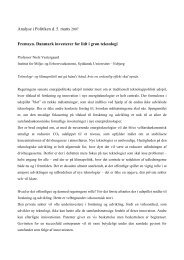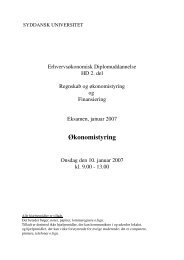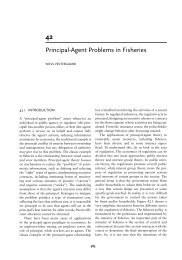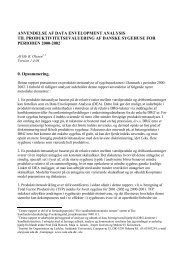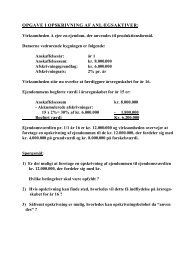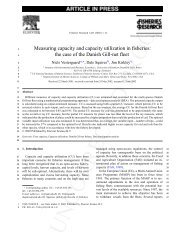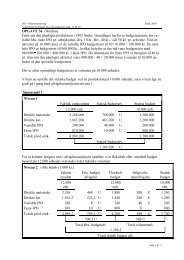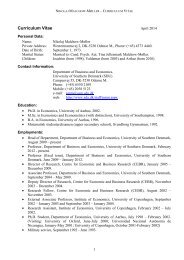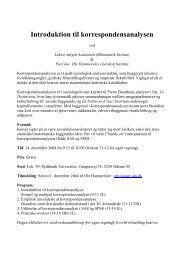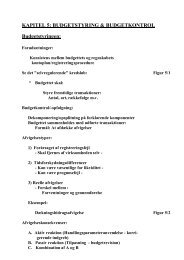the significance <strong>of</strong> strategic choices <strong>and</strong> leadership processes (“political craft<strong>in</strong>g” <strong>and</strong> “politicalentrepreneurship”). The structural factors have a subjective side <strong>in</strong> case economic growth <strong>and</strong> socialmobility are decl<strong>in</strong><strong>in</strong>g such as <strong>in</strong> the first years after the break-through. When the economic growth<strong>and</strong> social mobility decl<strong>in</strong>e, group consciousness tends to <strong>in</strong>crease <strong>and</strong> challenge the politicalsystem.At the beg<strong>in</strong>n<strong>in</strong>g the political parties tended to have weak organizations with only little presenceoutside the big towns <strong>and</strong> tenuous ties to the civil societies. Tehy have to be boradly def<strong>in</strong>ed<strong>in</strong>clud<strong>in</strong>g well organized mass parties as well as pro-parties, loose political associations <strong>and</strong> clubs,political factions <strong>and</strong> movements. Furthermore, <strong>in</strong> several cases the parties tended to be cadreconfigurations, not mass organizations such as had been the case <strong>in</strong> the West. As already said, mostparties were established spontaneously <strong>in</strong> the wake <strong>of</strong> the demise <strong>and</strong> collapse <strong>of</strong> the old systems.Only <strong>in</strong> Janos Kadar’s Hungary the foundation <strong>of</strong> political parties took place over one-two years,for that reason we did not f<strong>in</strong>d broadly based anti-communist movement parties such as <strong>in</strong> theCzech Republic (The Civic Forum), Slovakia (Public Aga<strong>in</strong>st Violence), Pol<strong>and</strong> (Solidarity) orBulgaria (SDS). The political capital, i.e. the spontaneous support from the society, was high, butmore short-term than first expected. As noted by Abby Innes (Innes, 2002), at the same time theEastern European parties had to satisfy two constituencies, one <strong>in</strong>ternal, the other external, i.e. IMF<strong>and</strong> the EU, sometimes with the very existence <strong>of</strong> the latter <strong>in</strong>hibit<strong>in</strong>g the development <strong>of</strong> theformer.Opposite <strong>in</strong> Western Europe political parties <strong>in</strong> the East were established as mass parties, <strong>and</strong> theyhad to f<strong>in</strong>d their social base by “look<strong>in</strong>g after their voters”. ”). The weak l<strong>in</strong>ks to the voters impliedthat the parties <strong>of</strong>ten miscalculated the voter preferences. That took place at the first free elections,at which the postcommunist successor partiets overestemated electoral support, at <strong>in</strong> tha case <strong>of</strong> thePolish 1993 election, when the “post-communist” parties did surpris<strong>in</strong>gly well. Wek l<strong>in</strong>kages to thesocial gropups <strong>and</strong> low party <strong>in</strong>stitutionalization made the parties more dependent on the media,what might be a danger to the freedom <strong>of</strong> the press. In addition, the boundaries between parties <strong>and</strong><strong>in</strong>terest groups tended to be porous. In general, the legacy <strong>of</strong> the communist past seemed to had an“anti-political” bear<strong>in</strong>g on the nascent party systems <strong>and</strong> party types. To the extent the label”political parties” can be used, it has to be used <strong>in</strong> the ”m<strong>in</strong>imalist” sense <strong>and</strong> parties have to beseen as political units that put forward c<strong>and</strong>idates on common lists at the national elections- <strong>and</strong> notmuch more.The political parties are only able to decide the political agenda if a majority <strong>of</strong> the electorate feel atleast as well represented through the political parties as through the different <strong>in</strong>terest groups, e.g.trade unions, the church, the military or, <strong>in</strong> the worst case, mafia-type economic organizations orother k<strong>in</strong>ds <strong>of</strong> illegal networks 4 . Shadow <strong>in</strong>stitutionalisation was not limited to countries on Balkan<strong>and</strong> <strong>in</strong> the CIS. Specific for Pol<strong>and</strong> has been the strong position <strong>of</strong> the church <strong>and</strong> to some extentalso the trade unions (Solidarnost <strong>and</strong> OPZZ). If that does not take place, a shadow<strong>in</strong>stitutionalisation will be the result, giv<strong>in</strong>g the church, the military or mafia-like <strong>in</strong>stitutions astrong position at the expense <strong>of</strong> democratic elected <strong>in</strong>stitutions such as parties <strong>and</strong> governments. Inthe CEEC’s the new parties never became mass parties, rather post-communist catch-all parties,later they were transformed to electoral-pr<strong>of</strong>essional cartel parties.4 In the m<strong>in</strong>imal sense political parties can be def<strong>in</strong>ed as ”any group that presents at elections <strong>and</strong> is capable <strong>of</strong> plac<strong>in</strong>gthrough elections c<strong>and</strong>idates for public <strong>of</strong>fice” (Sartori, 1976:64).10
The party fragmentarization was high, especially <strong>in</strong> the first phase. <strong>Party</strong> fission <strong>and</strong> party fusions,<strong>of</strong>ten <strong>in</strong> the shape <strong>of</strong> party federations <strong>and</strong> umberella parties were frequent. Furthermore, high focuson identity politics <strong>and</strong> symbol politics <strong>and</strong> weak l<strong>in</strong>ks to society gave the new parties specialcharacteristics. The <strong>in</strong>stitutionalisation was sporadic, at best. The “re<strong>in</strong>vention <strong>of</strong> politics” tookplace <strong>in</strong> a political <strong>and</strong> ideological vacuum without clear l<strong>in</strong>ks to the most important social groups,<strong>and</strong> the collapse <strong>of</strong> the old systems quickly gave space for an almost unlimited fight between protodemocraticactors (”total articulation”), between spokesmen for the old system <strong>and</strong> the opposition(”we versus them”) <strong>and</strong>, not to forget, between groups <strong>in</strong>side the two opposite camps “betweenus”). Without the common enemy the former dissidents found their “enemies” also <strong>in</strong>side their owncamp.Both the old communist parties <strong>and</strong> the new movement parties laid claim to ”represent the people”,thereby act<strong>in</strong>g <strong>in</strong> a catch-all way. Conservative-traditionalistic, e.g. Solidarity <strong>in</strong> Pol<strong>and</strong>, <strong>and</strong>neoliberal parties, e.g. ODS <strong>in</strong> the Czech Republic, behaved like premature catch-all partiesappeal<strong>in</strong>g to voters from all social strata. Opposite, medium-sized parties seemed to act like <strong>in</strong>terestbased <strong>and</strong> class orientated parties, to a large extent rely<strong>in</strong>g on ”automatic” votes <strong>of</strong> their directconstituencies (Ágh, 1998:115).It has been argued that new anti-communist movement parties resembled the old communist partiesas regards the political discourses, <strong>in</strong>stitutions <strong>and</strong> policy style. For many not only reformCommunists, but also former dissidents became the “other”- i.e. bound up <strong>in</strong> communist party type<strong>in</strong>trigues, not represent<strong>in</strong>g the normal electorate <strong>and</strong> therefore becom<strong>in</strong>g <strong>in</strong>appriopriaterepresentatives <strong>of</strong> the people (Innes, 2001:87). Paul G. Lewis argued that the new anti-communistparties were disposed to:”mirror the <strong>in</strong>clusive, monolithic communist organization; their antagonism to state authority; their<strong>in</strong>cl<strong>in</strong>ation to strive <strong>in</strong> political action for broad symbolic expression rather than grouprepresentation all seemed <strong>in</strong> some ways to po<strong>in</strong>t as much back to the practices <strong>and</strong> structures <strong>of</strong> thetraditional Soviet style communism as forward to the practices <strong>and</strong> structures <strong>of</strong> the traditionalSoviet-style communism as forward to the processes <strong>of</strong> modern democracy <strong>and</strong> structures <strong>of</strong>Western pluralism” (Lewis, 1994:264).The political parties can be formed either <strong>in</strong> an exogenous way, i.e. under the <strong>in</strong>fluence <strong>of</strong> voters’preferences <strong>and</strong> other ways <strong>of</strong> <strong>in</strong>fluence from outside, or <strong>in</strong> an endogeneous way, i.e. accord<strong>in</strong>g thedynamics <strong>in</strong>side the exist<strong>in</strong>g parties or between the parties on the national level. Often theclientelistic characteristics have been strik<strong>in</strong>g, <strong>in</strong> some cases <strong>in</strong>volv<strong>in</strong>g the economic sector. On theone side the party identities were created by <strong>in</strong>terplay between the past <strong>and</strong> the present, on the otherside between the national <strong>and</strong> the <strong>in</strong>ternational level or between the national <strong>and</strong> regional level. Theweight on the past, the present <strong>and</strong> the future has been different. The movement parties may have apredom<strong>in</strong>antly historically derived identity, thanks to a strong “foundation myth”, or apredom<strong>in</strong>antly presently derived identity, i.e. related to the day-to-day politics. In the last case theparty identity is shaped primarily accord<strong>in</strong>g to what Sartori has described as contemporary politicalappeals.In the former Yugoslavia <strong>and</strong> Russia, elections on republican level took place before the electionson the national level. The parties were chiefly regionally based, thereby underm<strong>in</strong><strong>in</strong>g the legitimacy<strong>of</strong> the central authorities <strong>and</strong> those parties that were reach<strong>in</strong>g the whole country. Strong11
- Page 3: “This provisional situation chara
- Page 6 and 7: marketisation and privatisationshor
- Page 8 and 9: purposes, are channels for “expre
- Page 12 and 13: presidentialism gave rise to “flo
- Page 14 and 15: antipolitics and reinforcement of a
- Page 16 and 17: In the late 1990’s elections most
- Page 18 and 19: determined primarily by “politica
- Page 20 and 21: politics and antipolitics, all sign
- Page 22 and 23: which attitudes to state regulation
- Page 24 and 25: Anti-communism has been defined in
- Page 26 and 27: elections and the Slovak communists
- Page 28 and 29: Cartel agreementsbetter representat
- Page 30 and 31: Basically the absence of clear cons
- Page 32 and 33: After 1989 different types of polit
- Page 34 and 35: complex project for transition unde
- Page 36 and 37: window of opportunity in spite of s
- Page 38 and 39: analyses of party institutionalizat
- Page 40 and 41: political messages and slogans. Thu
- Page 42 and 43: well established party culture may
- Page 44 and 45: expected, much due to the many spli
- Page 46 and 47: Furthermore, the polarisation on el
- Page 48 and 49: Finally, Solidarity can also be con
- Page 50 and 51: whole, on the one side an authorita
- Page 52 and 53: The economic recession and the grav
- Page 54 and 55: election defeat more cooperation an
- Page 56 and 57: The formation of AWS can be conside
- Page 58 and 59: group. RS AWS constituted the Chris
- Page 60 and 61:
According to the original plans the
- Page 62 and 63:
values. According to Rybicki, as so
- Page 64 and 65:
AWS should fight against all types
- Page 66 and 67:
2001 parliamentary election, howeve
- Page 68 and 69:
and workers voted ZChN. At the 1993
- Page 70 and 71:
The League has been considered as a
- Page 72 and 73:
establishment like than LPR’s. Th
- Page 74 and 75:
jobs in rural areas, especially sma
- Page 76 and 77:
industrial policy. According to the
- Page 78 and 79:
pressurizing the government to give
- Page 80 and 81:
democrats, thereby locating itself
- Page 82 and 83:
To conclude, the Freedom Union (UW)
- Page 84 and 85:
Polish middle class. Thus, in Janua
- Page 86 and 87:
such as KSCM and KSS in The Czech R
- Page 88 and 89:
The SLD leaders were mainly recruit
- Page 90 and 91:
the falling popular support for pri
- Page 92 and 93:
innovation was formation of the pol
- Page 94 and 95:
place after talks with each applica
- Page 96 and 97:
Has the Left any freedom of manoeuv
- Page 98 and 99:
medicine, changes in the labour cod
- Page 100 and 101:
The Labour Union (UP), Democratic U
- Page 102:
Nevertheless, before that had taken



